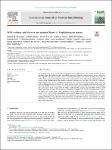Wild rodents and shrews are natural hosts of Staphylococcus aureus
Mrochen, Daniel M.
Schulz, Daniel
Fischer, Stefan
Jeske, Kathrin
El Gohary, Heba
Reil, Daniela
Imholt, Christian
Trübe, Patricia
Suchomel, Josef
Tricaud, Emilie
Jacob, Jens
Heroldová, Marta
Bröker, Barbara M.
Strommenger, Birgit
Walther, Birgit
Ulrich, Rainer G.
Holtfreter, Silva
Laboratory mice are the most commonly used animal model for Staphylococcus aureus infection studies. We have previously shown that laboratory mice from global vendors are frequently colonized with S. aureus. Laboratory mice originate from wild house mice. Hence, we investigated whether wild rodents, including house mice, as well as shrews are naturally colonized with S. aureus and whether S. aureus adapts to the wild animal host. 295 animals of ten different species were caught in different locations over four years (2012–2015) in Germany, France and the Czech Republic. 45 animals were positive for S. aureus (15.3%). Three animals were co-colonized with two different isolates, resulting in 48 S. aureus isolates in total. Positive animals were found in Germany and the Czech Republic in each studied year. The S. aureus isolates belonged to ten different spa types, which grouped into six lineages (clonal complex (CC) 49, CC88, CC130, CC1956, sequence type (ST) 890, ST3033). CC49 isolates were most abundant (17/48, 35.4%), followed by CC1956 (14/48, 29.2%) and ST890 (9/48, 18.8%). The wild animal isolates lacked certain properties that are common among human isolates, e.g., a phage-encoded immune evasion cluster, superantigen genes on mobile genetic elements and antibiotic resistance genes, which suggests long-term adaptation to the wild animal host. One CC130 isolate contained the mecC gene, implying wild rodents might be both reservoir and vector for methicillin-resistant . In conclusion, we demonstrated that wild rodents and shrews are naturally colonized with S. aureus, and that those S. aureus isolates show signs of host adaptation.
Dateien zu dieser Publikation

